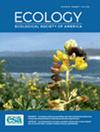用种群生长等斜线解释幼鱼生长和存活率的野外测量结果
IF 4.3
2区 环境科学与生态学
Q1 ECOLOGY
引用次数: 0
摘要
幼鱼存活率和生长率通常是研究人口增长率及其对人口增长的影响。对于那些能够从幼崽捕食者那里获得一个大小避难所的物种,在较小的脆弱尺寸上花费的时间预计会影响种群动态。但是,幼鱼生长和生存对种群增长的相互作用很少从理论上加以说明,而且这些概念的大多数研究都是在实验环境中进行的。这两种速率的相互作用可以应用于物种多样性的补充变化的实地研究,这些研究可以用人口模型和等斜线来评估。我们从概念上说明了文献中海洋、陆地和淡水等斜线的潜在用途,然后演示了每年淡水腹足动物(佛罗里达苹果蜗牛,Pomacea paludosa)的人口等斜线的使用。使用已发表的规模指数人口模型,我们构建了一个零种群增长等斜线,用于幼鱼生长和存活率的理论组合。然后,在招募期间,我们将不同的捕食者组合和季节性环境条件(即水深和温度)结合起来,量化了两个湿地的每日幼鱼存活和生长情况。在较冷的旱季,日成活率较低,而在较暖的湿(雨)季,日成活率较快。枯水期幼鱼生长和存活的参数组合预测种群数量下降(λ < 1),而丰水期的比率预测种群数量处于替代状态(λ = 1)或增加。当对整个年度补充窗口的参数进行组合时,预计这两个湿地的种群数量将下降。对影响繁殖率的水文条件变化的定性预测是可靠的,但在较好的水文条件下,一个种群接近替代。我们的人口等斜线方法为实地测量的人口比率提供了人口动态背景,确定了人口生存和增长的重要时间变化,并为未来的调查和管理提出了新的假设。我们鼓励其他人考虑发展人口等斜线来解释生命早期人口比率在空间和时间变化的环境条件下的变化。本文章由计算机程序翻译,如有差异,请以英文原文为准。
Interpreting field measurements of juvenile growth and survival rates with population growth isoclines
Juvenile survival and growth rates are commonly studied demographic rates with consequences for population growth. For species that can achieve a size refuge from juvenile predators, the time spent at smaller vulnerable sizes is expected to affect population dynamics. But the interactive effects of juvenile growth and survival on population growth are rarely illustrated theoretically, and most studies of these concepts have been in experimental settings. The interactive effects of the two rates have applications to field studies of recruitment variation for a diversity of species that could be assessed with demographic models and isoclines. We conceptually illustrate the potential use of demographic isoclines for marine, terrestrial, and freshwater examples in the literature, and then demonstrate the use of a demographic isocline for an annual freshwater gastropod (Florida Apple Snail, Pomacea paludosa ). Using a published size‐indexed demographic model, we constructed a zero‐population growth isocline for theoretical combinations of juvenile growth and survival rates. We then quantified daily juvenile survival and growth in two wetlands twice during the recruitment period, incorporating variable predator assemblages and seasonal environmental conditions (i.e., water depth and temperature). Daily juvenile survival rates were lower in the cooler dry season and juvenile growth was faster in the warmer wet (rainy) season. Parameter combinations of juvenile growth and survival in the dry season predicted declining populations (λ < 1), while rates from the wet season predicted populations at replacement (λ = 1) or increasing. When parameters were combined for the full annual recruitment window, populations were projected to decline in both wetlands. The qualitative predictions were robust to variation in hydrologic conditions affecting reproductive rates, but with better hydrologic conditions, one population was near replacement. Our demographic isocline approach provided population‐dynamic context to field‐measured demographic rates, identified important temporal variation in survival and growth for the population, and generated new hypotheses for future investigation and management. We encourage others to consider developing demographic isoclines to interpret variation of early life stage demographic rates across spatially and temporally variable environmental conditions.
求助全文
通过发布文献求助,成功后即可免费获取论文全文。
去求助
来源期刊

Ecology
环境科学-生态学
CiteScore
8.30
自引率
2.10%
发文量
332
审稿时长
3 months
期刊介绍:
Ecology publishes articles that report on the basic elements of ecological research. Emphasis is placed on concise, clear articles documenting important ecological phenomena. The journal publishes a broad array of research that includes a rapidly expanding envelope of subject matter, techniques, approaches, and concepts: paleoecology through present-day phenomena; evolutionary, population, physiological, community, and ecosystem ecology, as well as biogeochemistry; inclusive of descriptive, comparative, experimental, mathematical, statistical, and interdisciplinary approaches.
 求助内容:
求助内容: 应助结果提醒方式:
应助结果提醒方式:


